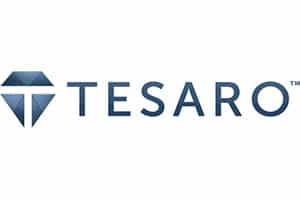 Tesaro’s niraparib has become the third PARP inhibitor to be approved for marketing, with the FDA giving the nod for the drug as a therapy for women with epithelial ovarian, fallopian tube or primary peritoneal cancer.
Tesaro’s niraparib has become the third PARP inhibitor to be approved for marketing, with the FDA giving the nod for the drug as a therapy for women with epithelial ovarian, fallopian tube or primary peritoneal cancer.
Although it will reach the market behind AstraZeneca’s Lynparza (olaparib) and Clovis Oncology’s Rubraca (rucaparib) when it launches next month, Tesaro thinks its drug – which will be sold as Zejula in the US – has a competitive advantage in not requiring BRCA mutation or other biomarker testing before use.
BRCA mutations are seen in around 30% of ovarian cancer patients so niraparib’s label should allow it to cover the full spectrum of post-platinum recurrence patients, without the need to have a biomarker test upfront.
The approval is based on the results of the ENGOT-OV16/NOVA trial, which enrolled 553 patients with recurrent ovarian cancer who exhibited a complete or partial response to their most recent platinum-based chemotherapy.
Giving niraparib as a maintenance therapy was associated with an improvement in progression-free survival (PFS), regardless of BRCA mutation or if the patients were positive for homologous recombination deficiency (HRD), a biomarker for inefficient DNA repair that predicts a poor prognosis. The improvement was durable for at least two years after chemotherapy.
“Maintenance therapy is an important part of a cancer treatment regimen for patients who have responded positively to a primary treatment,” said Richard Pazdur, director of the FDA’s Oncology Center of Excellence. “Zejula offers patients a new treatment option that may help delay the future growth of these cancers, regardless of whether they have a specific genetic mutation.”
Recognising the clinical potential of the drug, the US regulator awarded niraparib both a fast track and priority review for ovarian, fallopian tube or primary peritoneal cancer.
“Ovarian cancer is a dreadful disease, for which there have been few therapeutic advances made in the past decade,” said Tesaro’s chief operating officer Mary Lynne Hedley earlier this month.
“The effectiveness of platinum-based chemotherapy diminishes over time, and PFS and platinum-free intervals generally become shorter after each round of platinum therapy.” Extending the response to platinum provides a meaningful benefit for patients, who today have few treatment options, she added.
Credit Suisse still predicts that Lynparza will lead the market in 2020, with sales of $1.6bn and just ahead of Rubraca, although they see rapid uptake for niraparib from a standing start with more than $1bn in sales in that year.
The approval comes at a buoyant time for Tesaro, which is still rolling out its first commercial product in the US – the chemotherapy-induced nausea and vomiting drug Varubi (rolapitant) – and has a positive CHMP opinion for that drug in Europe which should allow the firm to start launches next quarter. Niraparib was also filed with the EMA last October with a verdict due later this year.
By the end of the year, the company could have a new intravenous formulation of Varubi on the market in the US and niraparib on sale in both the US and Europe, consolidating its transition from a research-stage to a commercial-stage pharma company.




